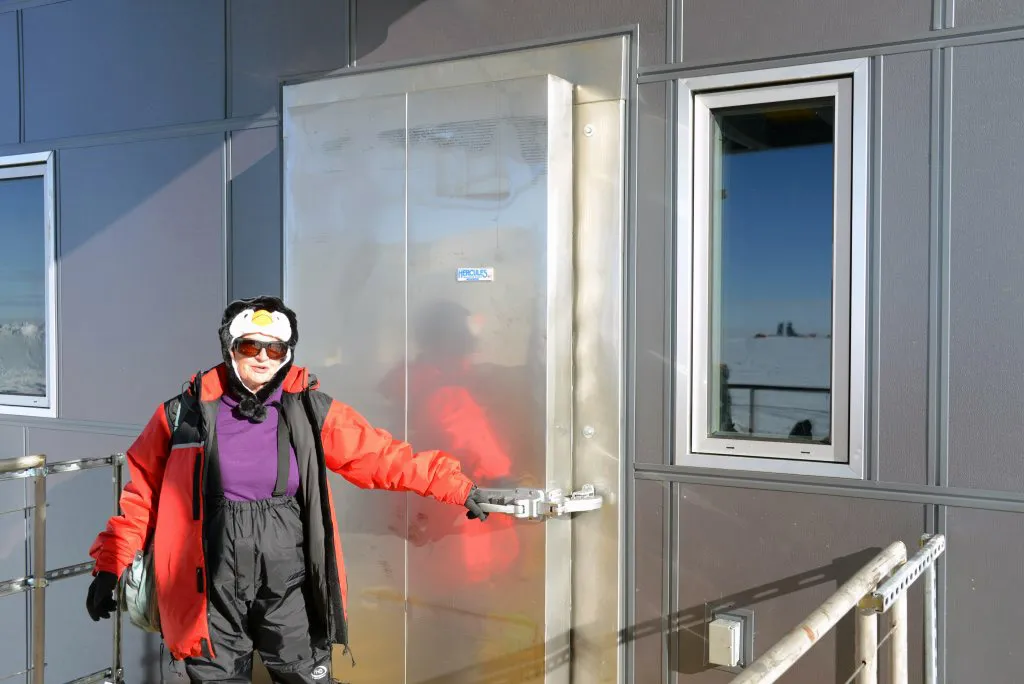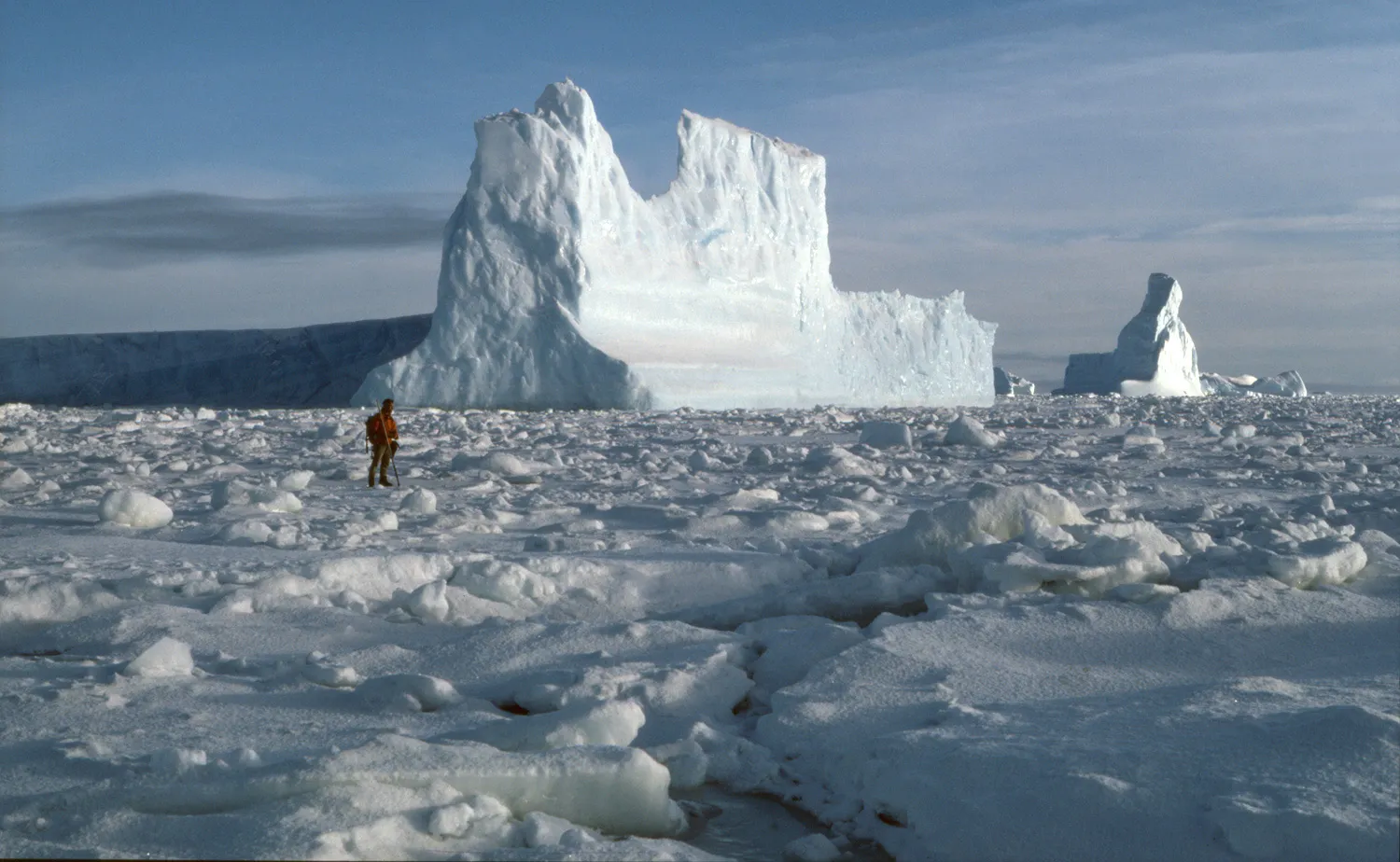| Do people live in Antarctica in the winter? | There is a winter population of about 1,000, most will be there for a year in total, some for two years. |
| How do people survive in Antarctica in the winter? | Mainly by staying on the station. By not leaving beyond a short walk outside during the permanent night By not travelling for too far and by staying put in a tent or hut if caught out in a blizzard rather than trying to go back to the station. There are often rope lines between buildings and it is required to hold onto them and follow them along to the next entrance if you must go outside in bad conditions. In a white-out you could wander off, get lost and get a cold injury or even die while still being close to base. |
| How do animals survive in Antarctica in the winter? | By leaving the coldest regions before winter arrives and moving north. Emperor penguins are the only large animals that stay in the Antarctic deep south throughout the winter, they are highly adapted to do so. |
| What design features do modern Antarctic stations have to cope with the extreme environment? | Often built raised above the ground so wind and snow blow underneath instead of burying them. Really thickly insulated walls, floor, windows and ceilings. Massive insulated doors that form a seal around them when closed to prevent the wind, snow and cold air getting in. |
| What sort of clothes do people wear? | Normal clothes indoors. Outdoors the layering system is used with clothing issued to suit the conditions on each particular station. Long thermal underwear, then one or two soft insulating layers and then a windproof outer layer usually with more insulation. Long mittens, tall insulated boots with a thick insulating sole, a hat or balaclava and neck gaiter or scarf. All of these in extreme cold weather weight and design. |
| Can people leave in the winter? | Not usually. There have been occasional and rare flights to deal with medical emergencies, but for the vast majority once the last ship or flight leaves around March or April, there will be no more transport in or out until October or November after the winter. |
Longer Explanation - People:
The great majority of people in Antarctica in the winter are living on well equipped research stations (100% of them most years) that are designed to resist the worst that the weather can throw at them. These communities are self contained and have enough resources of food, fuel and everything else that their compliment might need for much longer than a single winter (in case something goes badly wrong), so basic physical on-station survival is not so much of a problem.
Before the last ship or flight leaves at the end of the summer, those who will over winter will have been thoroughly trained in all aspects of their own jobs, on how to survive in Antarctica, how to run the station to its best advantage and how to avoid icy injury and frozen death. Such is the level of training that sustaining a cold injury is in many cases considered to be a result of negligence and therefore self inflicted.
 Crevasse rescue techniques
are some of the skills that need to be learnt
Crevasse rescue techniques
are some of the skills that need to be learnt
 An
external door on the South Pole station, like a big freezer
door, but to keep the cold outside
An
external door on the South Pole station, like a big freezer
door, but to keep the cold outside
Despite the difficulties and dangers, most of those who have ever overwintered in Antarctica agree that the winter is really the best time to be there and is why they wanted to be there in the first place. It gives an opportunity to experience some exciting, adventurous experiences that are just not available elsewhere, the harsh beauty of an Antarctic winter is like no other and you get a chance to see the seasons develop and change gradually. Depending on where you are in Antarctica, you may also see wildlife in great numbers, seals, penguins and other birds arriving to breed and rear their young at very close quarters.
One of the most difficult things to deal with is the isolation from the rest of the world, though this can also have its own advantages in that you are largely left to your own devices work-wise, maybe alone or part of your small team depending on what your job is. Many of the advantages or disadvantages of spending any length of time in Antarctica are a matter of perspective, what some will see as a great opportunity will be regarded as a form of torture for others.
There are two aspects to surviving in Antarctica in the winter time, the physical world of the extreme climate outside and amongst the station buildings and the mental world inside your head as you deal with the isolation and somewhat "institutionalized" way of life that communal living inevitably leads to.
People miss friends and family from home of course, but there is also the everyday unexpected events and meetings that you don't realise you enjoy until they are gone. It depends on the individual and for some the predictability of life and events is very much a positive, though monotony, repetitiveness and boredom become an issue for almost everyone at some point, especially when the weather confines everyone to the station for long time periods and there isn't even much to look at out of the windows.
There are other factors that can make life in the Antarctic winter challenging:
Daylength - Changes in daylength can be difficult to cope with as these become more extreme with closeness to the Pole. At the Pole, there is effectively one "day" a year in that there is 6 months of constant daylight followed by 6 months of constant darkness. The darkness isn't complete at each end of its duration as the sun comes close below the horizon providing an increasing amount of twilight each day until it rises above the horizon and there is remaining twilight after it dips again. Nonetheless, there are months of continual dark. As you move away from the pole, this extreme situation reduces, many locations in Antarctica have from days to weeks in the winter when the sun doesn't rise at all or just rises for an hour or two each day.
In the summer, this situation is reversed with extreme amounts of daylight and very little or no darkness.
Sleep difficulties can arise as there becomes no clear natural indicator of the passage of time, the phrase "big eye" is sometimes used to describe the insomnia that arises from continuous daylight in the summer.
Dryness - Antarctica is a desert, parts of Antarctic are the driest desert environment on earth. The high plateau of the ice cap is most strongly affected. The air is very dry due to an almost total lack, or total lack, of water vapour. Dehydration, dry skin and dry lips can be a problem as the dryness is not an obvious issue in such a cold climate, sometimes (though rarely) an intra-venous drip is needed to help people hydrate properly.
Altitude - Antarctica is the highest continent with an average height of 7,545 feet (2,300 m) this is more than twice the average height of Asia, the next highest continent. The pole is at 9,300 feet (2,834 m) and there are a number of high altitude research stations where the air pressure is low and oxygen is also in relatively short supply, this places extra stresses and difficulties for people working there, particularly when they first arrive until they are acclimatised.
Many people go into a state of "psychological hibernation" for at least some part of their time during their winter spent in Antarctica.
Antarctic winter population - 1,000
 Dressed for a warm day
in the sun at the South Pole in summer
Dressed for a warm day
in the sun at the South Pole in summer
 At the South Pole on Christmas
Day, mid-day, or is it mid-night?
At the South Pole on Christmas
Day, mid-day, or is it mid-night?
Animals:
Antarctica has huge numbers of animals that arrive seasonally in the summer to feed, breed, moult and leave again before the winter arrives again. Penguins, seals, whales and other birds head north when the days begin to shorten. They do this to escape the extreme cold, and also because the shortening days mean that food production that was abundant in the long intense summer days slows enormously, sea-ice builds up now around the continent during the winter and approximately doubles the area occupied by continental Antarctica. All of which adds up to the continent and surrounding seas being no place to be for nearly all of the animals that were there over the summer.
There is one notable exception to the rule where all animals head north and away from the continent and that is of Emperor penguins which deliberately remain in Antarctica throughout the harshest times. Not only do they stay behind, they breed, lay and hatch their eggs and rear the chicks at this time. And just when you thought they couldn't do anything any more extreme, the males incubate the egg for an average of 115 days but up to 120, during which time they don't feed and will lose about 40% of their body weight.
 An emperor penguin huddle with some
recently hatched chicks with their parents
An emperor penguin huddle with some
recently hatched chicks with their parents
 As the chicks grow they
become too big to be kept warm by their parent, they have very
dense and effective down insulation
As the chicks grow they
become too big to be kept warm by their parent, they have very
dense and effective down insulation
Find out more about Emperor penguins are adapted
Acknowledgements
picture use: South Pole
door courtesy of John Walker, Fourmilab.
Psychological Hibernation
in Antarctica, more
here.



